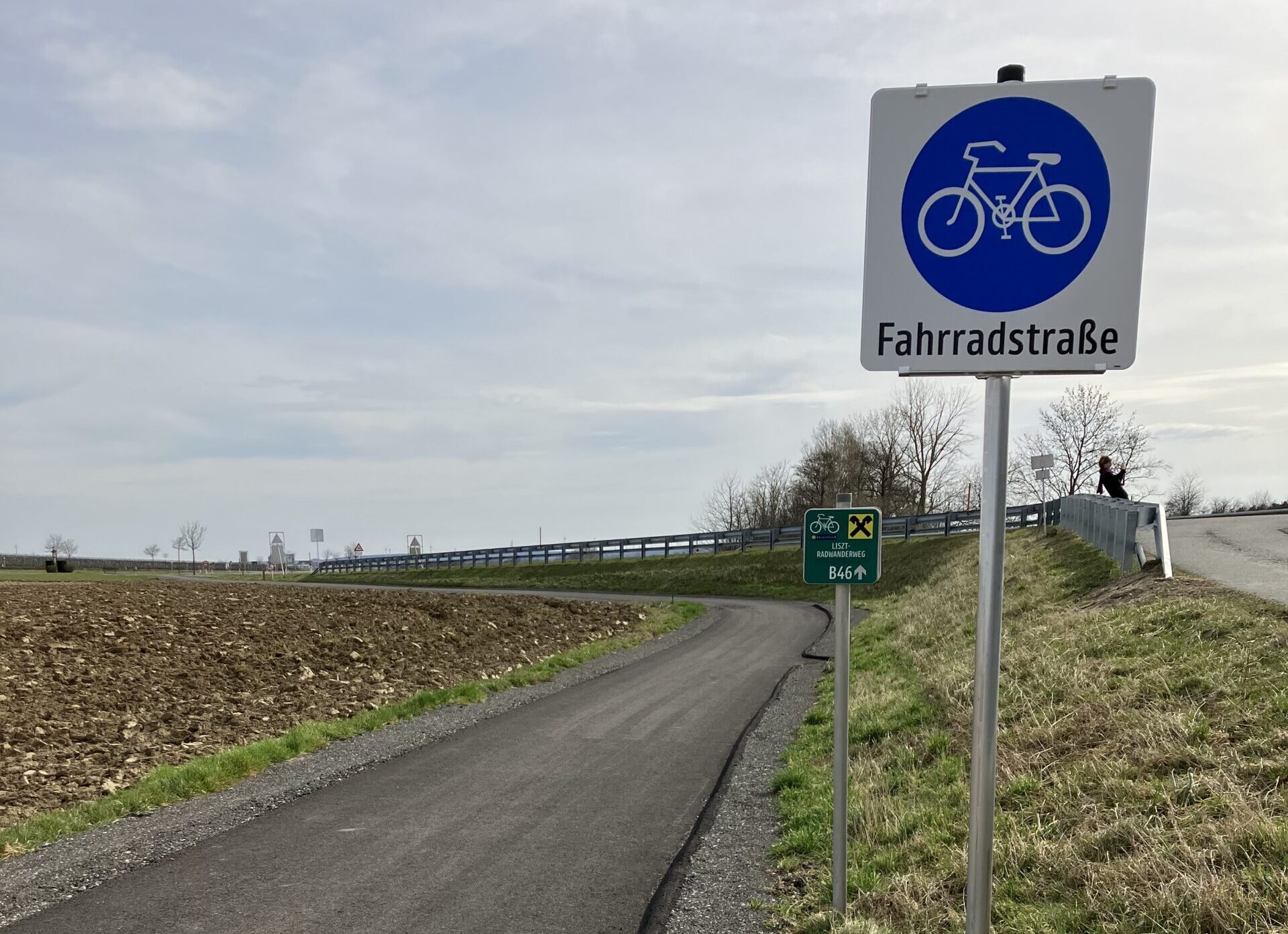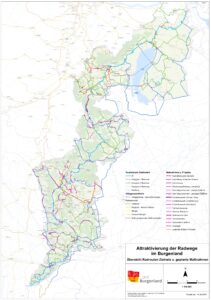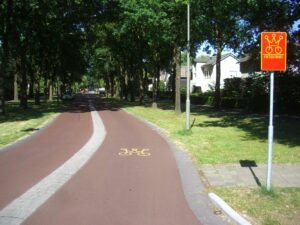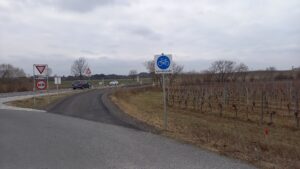Cycle streets in Burgenland as an opportunity for rural areas

In addition to the previously dominant use of bicycle streets in an urban context, completely new fields of application are opening up in rural areas to create attractive cycling networks. At the beginning of 2024, there were around 80 kilometres of these cycle streets in the federal states. Our Cycle Competence members Mobility Centre Burgenland and Radlobby provide an insight into the instrument of rural cycle streets using the example of Burgenland and thus show the potential of this planning tool.
As is well known, Burgenland is flat in many places and hilly in others – especially in central and southern Burgenland. The largest city among the 171 towns and municipalities is the provincial capital Eisenstadt with around 16,000 inhabitants. There are many small and very small municipalities. There is no densely populated region. The distances between the municipalities, towns and cities are therefore relatively long. Many Burgenlanders travel long distances to work, yet half of the journeys in Burgenland are shorter than 5 km. At 683 cars per 1000 inhabitants in 2023, the level of motorisation was the highest of all Austrian federal states.
The rural roads rethought
The road network in Burgenland is by far the longest of all the federal states (with the exception of Vienna), both in terms of population and area. At 4.4 per cent of the provincial area, the degree of sealing is the third highest of all the provinces. This makes it all the more important to use existing paths instead of building new ones. On the vast majority of roads and paths outside built-up areas, the maximum permitted speed is 70 or even 100 km/h, which is highly unsuitable for mixed traffic of pedestrians, cyclists and vehicles. Many of the connecting roads between villages away from the main roads are surfaced or unsurfaced farm tracks, some of which are unsuitable for everyday cycle traffic.
The existing roads can be used by all vehicles and are therefore not optimised for cycle traffic. The maximum permitted speed is often 100 km/h – as is also the case on many of the asphalted and well-developed country roads in the open countryside. At present, there are still many sections where cycle traffic still takes place either on secondary roads with poor surfaces and high speed limits and sometimes detours in mixed traffic with agricultural vehicles or on country roads with high speeds in mixed traffic with motor vehicles.
Developments in the transport sector make it necessary to take measures to shift to eco-mobility and increase cycling by offering attractive options. Attention must also be paid to aspects of sealing. When creating cycle networks, it is advantageous in this respect if routes that are not overly frequented can be shared by cyclists and occasional agricultural traffic.
The task of building and maintaining municipal infrastructure poses major challenges for many municipalities, of which road construction is a significant part. According to the Austrian Association of Municipalities, around 1.3 billion euros were spent on road construction in Austria in 2020, which corresponds to 154 euros per inhabitant. The cost pressure is enormous, especially in sparsely populated areas, and cost-efficient solutions with durability and additional benefits are required. In view of the major challenges and at the same time limited possibilities, the instrument of extra-urban cycle lanes shows its strengths.
Expansion of the cycle network in Burgenland
In Burgenland, there are approx. 1,200 km of what the BMK defines as a ‘safe cycling network’ with all kinds of functions (including 30 km/h cycle paths, footpaths, cycle lanes, residential streets, etc.).
Since 2021, Burgenland has had a provincial cycle destination network that summarises all tourist cycle routes, supra-regional everyday cycle routes and regional basic cycle networks. Since 2022, the province of Burgenland has been implementing the so-called ‘Attractiveness Programme for Cycle Routes’ – the province’s cycle expansion offensive. As part of this programme, around 25 projects are built each year, some of which are renovations of existing infrastructure and some of which are new constructions.
Target network Burgenland
In 2023, the first cycle street in Burgenland was decreed. This is the everyday cycle route from Lackendorf to Horitschon in central Burgenland. Parallel to the provincial road, there were sections of existing goods roads that were upgraded to cycle paths. New infrastructure was built in the missing sections. The entire route was upgraded to a 3.5 m wide carriageway and designated as a cycle road. A bridge structure was also required to close the gap in Lackenbach.
Typical cross-section of a cycle street outside built-up areas
Procedure: ‘The road to a cycle street’ in Burgenland
The cycle streets implemented to date in Burgenland are all part of the provincial cycle network. In co-operation with the municipalities, the province is responsible for project development, funding, planning and construction. After completion, the cycling infrastructure becomes the responsibility of the municipality to maintain. The respective municipality is responsible for the regulation of the cycle route itself. This is followed by a review of the ordinance by the district authority and then local publicity by means of the corresponding ‘cycle street’ traffic signs and any additional signs.
A municipality interested in setting up a cycle lane can contact the Burgenland Mobility Centre at office@b-mobil.info to clarify the possibilities, which will provide support with information.
High suitability of cycle streets for rural areas
Compared to a goods road, a cycle street offers many advantages for local authorities and users alike. For example, a maximum speed limit of 30 km/h applies and cyclists are allowed to ride side by side. However, it is also important that the infrastructure can be used for agricultural traffic, as they fulfil the important access function for properties and agricultural land.
Note: In the case of footpaths and cycle paths, use by ‘agricultural vehicles’ may be permitted outside built-up areas in accordance with Section 8a StVO. However, cars used by landowners to access their land (‘agricultural traffic’) do not fall under the term ‘agricultural vehicles’ in the strict sense (tractors, combine harvesters, etc.). This means that many properties would no longer be legally accessible by motor vehicle, which in some cases means that footpaths and cycle paths are out of the question.
In such cases, the out-of-town cycle lane is therefore the perfect option to
- create safe and attractive conditions for cyclists,
- at the same time allow landowners to continue using the path,
- avoid the creation of additional segregated paths by making existing infrastructure equally usable by cyclists and farmers, and
- being able to implement cycle networks with the support of klimaaktiv federal funding (cycle streets are eligible for funding, general goods roads are not).
The disadvantage of a cycle street compared to a mixed ‘footpath and cycle path’ is that pedestrians have to walk on the edge of the carriageway, which makes it somewhat less attractive for pedestrians. The frequencies of all users, including pedestrians, on Burgenland’s cycle lanes are currently and foreseeably at a tolerable level, so that no particular conflicts of use are expected in view of the comfortable width of the lane.
In the Netherlands, too, cycle streets outside built-up areas are a tried and tested instrument for creating main cycle routes between towns and cities. With the help of traffic filters and traffic organisation measures such as access restrictions, one-way regulations and speed limits, motorised traffic is reduced to a tolerable level. In addition to the actual road design itself, this effective motor vehicle traffic calming is the decisive measure for making mixed-use areas cycle-friendly.
Cycle street in the Netherlands
Soon to be 12 cycle streets in Burgenland
Cycle street in Pöttelsdorf (Burgenland)
After all legal and organisational issues were clarified in the course of the regulation and implementation of the first cycle street in Burgenland in 2023, three cycle street have now been implemented and nine more are under construction or before regulation/completion. In total, there will be 12 cycle streets with a total length of approx. 14.6 kilometres on 10 main cycle routes in Burgenland in the foreseeable future. The special feature: All of these cycle streets are located outside the urban area and thus serve to connect villages and municipalities.
Projects – realised
- Lackendorf-Neckenmarkt-Horitschon (2.2 km)
- Steinberg (1 km)
- Kirchfidisch-Güttenbach-Punitz (1.6 km)
More information at: https://www.b-mobil.info/de/fahrrad/news/detail/fahrradstrassen-im-burgenland
The first Burgenland cycle street in Lackendorf
Projects – in realisation
- Kobersdorf-Weppersdorf-Lindgraben (2.1 km, 2 sections)
- Großhöflein – Müllendorf (1.75 km, 2 sections)
- Strebersdorf – Frankenau (0.5 km)
- Lutzmannsburg (0.3 km)
- Raiding (2.2 km)
- Großpetersdorf-Kleinpetersdorf (0.7 km)
- Kukmirn-Eisenhüttl (2.3 km)
Togetherness and awareness
Although the type of cycle street and the rules of behaviour that apply there have been laid down by law since 2013, many citizens are still unfamiliar with them. However, as cycle streets and their traffic quality also depend on correct behaviour, there is still a lot of educational work to be done.
Since 2013, the bicycle lobby has been offering an illustrated legal guide for free download as a PDF at www.radlobby.at/recht and has been continuously promoting municipal information campaigns.
In the case of newly opened cycle streets, publication in the municipal gazette is just as suitable as the erection of large posters at the entrances to the cycle lane. In order to make the rules for using cycle streets clear to all users in Burgenland and to promote cooperation, the Burgenland Mobility Centre is planning an awareness-raising campaign for 2025. Among other things, it will include explanatory articles, digital subjects and construction fence posters that can be borrowed by municipalities. More information will follow at www.b-mobil.info
Review: First cycle streets in Austria’s federal states since 2013
2013: Austria’s first cycle street in Vienna (Kuchelauer Hafenstraße) https://www.fahrradwien.at/news/fahrradstrasse-kuchelau-wurde-verlaengert/
2013: First cycle street in Vorarlberg, in Hard
https://mobilitaetsprojekte.vcoe.at/fahrradstrasse-hard-1-fahrradstrasse-vorarlbergs
2013: First cycle street in Carinthia, in Klagenfurt https://www.kleinezeitung.at/kaernten/klagenfurt/4092539/Klagenfurt_Eigene-Strasse-fuer-Radler
2013: First cycle street in Tyrol, in Reutte https://www.meinbezirk.at/reutte/c-lokales/koenigweg-soll-radlern-gehoeren_a593974
2014: First cycle street in Salzburg, in the city of Salzburg https://www.salzburg24.at/news/salzburg/stadt/erste-fahrradstrasse-in-der-stadt-salzburg-45864601
2018: First cycle street in Styria, in Bad Radkersburg https://www.facebook.com/ARGUS.Steiermark/videos/1994033150669976/
2020: First cycle streets in Lower Austria, in St. Pölten
https://www.radlobby.org/noe/st-poelten-erste-fahrradstrassen-in-niederoesterreich/
2022: First cycle street in Upper Austria, in Wels
https://www.radmodellregion.at/erste-fahrradstrasse-oberoesterreichs-kommt-in-der-radmodellregion-wels-umland/
2023: First cycle street in Burgenland, in Lackendorf-Horitschon-Neckenmarkt
https://www.burgenland.at/news-detail/30-kilometer-radinfrastruktur-errichtet/
An annually updated overview of the length of cycle streets per federal state can be found in the Federal Ministry’s ‘Safe Cycling Network’ analysis: https://mobilitydata.gv.at/daten/sicheres-radverkehrsnetz-und-bikeride-erreichbarkeitsklassen
Illustrations and text: Christine Zopf-Renner (Mobility Centre Burgenland) and Roland Romano (Radlobby Österreich)
Cycling Competence Members in this article:
More articles with this member:
[crp]
Share this article:
Cycle streets in Burgenland as an opportunity for rural areas
Share this article:

In addition to the previously dominant use of bicycle streets in an urban context, completely new fields of application are opening up in rural areas to create attractive cycling networks. At the beginning of 2024, there were around 80 kilometres of these cycle streets in the federal states. Our Cycle Competence members Mobility Centre Burgenland and Radlobby provide an insight into the instrument of rural cycle streets using the example of Burgenland and thus show the potential of this planning tool.
As is well known, Burgenland is flat in many places and hilly in others – especially in central and southern Burgenland. The largest city among the 171 towns and municipalities is the provincial capital Eisenstadt with around 16,000 inhabitants. There are many small and very small municipalities. There is no densely populated region. The distances between the municipalities, towns and cities are therefore relatively long. Many Burgenlanders travel long distances to work, yet half of the journeys in Burgenland are shorter than 5 km. At 683 cars per 1000 inhabitants in 2023, the level of motorisation was the highest of all Austrian federal states.
The rural roads rethought
The road network in Burgenland is by far the longest of all the federal states (with the exception of Vienna), both in terms of population and area. At 4.4 per cent of the provincial area, the degree of sealing is the third highest of all the provinces. This makes it all the more important to use existing paths instead of building new ones. On the vast majority of roads and paths outside built-up areas, the maximum permitted speed is 70 or even 100 km/h, which is highly unsuitable for mixed traffic of pedestrians, cyclists and vehicles. Many of the connecting roads between villages away from the main roads are surfaced or unsurfaced farm tracks, some of which are unsuitable for everyday cycle traffic.
The existing roads can be used by all vehicles and are therefore not optimised for cycle traffic. The maximum permitted speed is often 100 km/h – as is also the case on many of the asphalted and well-developed country roads in the open countryside. At present, there are still many sections where cycle traffic still takes place either on secondary roads with poor surfaces and high speed limits and sometimes detours in mixed traffic with agricultural vehicles or on country roads with high speeds in mixed traffic with motor vehicles.
Developments in the transport sector make it necessary to take measures to shift to eco-mobility and increase cycling by offering attractive options. Attention must also be paid to aspects of sealing. When creating cycle networks, it is advantageous in this respect if routes that are not overly frequented can be shared by cyclists and occasional agricultural traffic.
The task of building and maintaining municipal infrastructure poses major challenges for many municipalities, of which road construction is a significant part. According to the Austrian Association of Municipalities, around 1.3 billion euros were spent on road construction in Austria in 2020, which corresponds to 154 euros per inhabitant. The cost pressure is enormous, especially in sparsely populated areas, and cost-efficient solutions with durability and additional benefits are required. In view of the major challenges and at the same time limited possibilities, the instrument of extra-urban cycle lanes shows its strengths.
Expansion of the cycle network in Burgenland
In Burgenland, there are approx. 1,200 km of what the BMK defines as a ‘safe cycling network’ with all kinds of functions (including 30 km/h cycle paths, footpaths, cycle lanes, residential streets, etc.).
Since 2021, Burgenland has had a provincial cycle destination network that summarises all tourist cycle routes, supra-regional everyday cycle routes and regional basic cycle networks. Since 2022, the province of Burgenland has been implementing the so-called ‘Attractiveness Programme for Cycle Routes’ – the province’s cycle expansion offensive. As part of this programme, around 25 projects are built each year, some of which are renovations of existing infrastructure and some of which are new constructions.
Target network Burgenland
In 2023, the first cycle street in Burgenland was decreed. This is the everyday cycle route from Lackendorf to Horitschon in central Burgenland. Parallel to the provincial road, there were sections of existing goods roads that were upgraded to cycle paths. New infrastructure was built in the missing sections. The entire route was upgraded to a 3.5 m wide carriageway and designated as a cycle road. A bridge structure was also required to close the gap in Lackenbach.
Typical cross-section of a cycle street outside built-up areas
Procedure: ‘The road to a cycle street’ in Burgenland
The cycle streets implemented to date in Burgenland are all part of the provincial cycle network. In co-operation with the municipalities, the province is responsible for project development, funding, planning and construction. After completion, the cycling infrastructure becomes the responsibility of the municipality to maintain. The respective municipality is responsible for the regulation of the cycle route itself. This is followed by a review of the ordinance by the district authority and then local publicity by means of the corresponding ‘cycle street’ traffic signs and any additional signs.
A municipality interested in setting up a cycle lane can contact the Burgenland Mobility Centre at office@b-mobil.info to clarify the possibilities, which will provide support with information.
High suitability of cycle streets for rural areas
Compared to a goods road, a cycle street offers many advantages for local authorities and users alike. For example, a maximum speed limit of 30 km/h applies and cyclists are allowed to ride side by side. However, it is also important that the infrastructure can be used for agricultural traffic, as they fulfil the important access function for properties and agricultural land.
Note: In the case of footpaths and cycle paths, use by ‘agricultural vehicles’ may be permitted outside built-up areas in accordance with Section 8a StVO. However, cars used by landowners to access their land (‘agricultural traffic’) do not fall under the term ‘agricultural vehicles’ in the strict sense (tractors, combine harvesters, etc.). This means that many properties would no longer be legally accessible by motor vehicle, which in some cases means that footpaths and cycle paths are out of the question.
In such cases, the out-of-town cycle lane is therefore the perfect option to
- create safe and attractive conditions for cyclists,
- at the same time allow landowners to continue using the path,
- avoid the creation of additional segregated paths by making existing infrastructure equally usable by cyclists and farmers, and
- being able to implement cycle networks with the support of klimaaktiv federal funding (cycle streets are eligible for funding, general goods roads are not).
The disadvantage of a cycle street compared to a mixed ‘footpath and cycle path’ is that pedestrians have to walk on the edge of the carriageway, which makes it somewhat less attractive for pedestrians. The frequencies of all users, including pedestrians, on Burgenland’s cycle lanes are currently and foreseeably at a tolerable level, so that no particular conflicts of use are expected in view of the comfortable width of the lane.
In the Netherlands, too, cycle streets outside built-up areas are a tried and tested instrument for creating main cycle routes between towns and cities. With the help of traffic filters and traffic organisation measures such as access restrictions, one-way regulations and speed limits, motorised traffic is reduced to a tolerable level. In addition to the actual road design itself, this effective motor vehicle traffic calming is the decisive measure for making mixed-use areas cycle-friendly.
Cycle street in the Netherlands
Soon to be 12 cycle streets in Burgenland
Cycle street in Pöttelsdorf (Burgenland)
After all legal and organisational issues were clarified in the course of the regulation and implementation of the first cycle street in Burgenland in 2023, three cycle street have now been implemented and nine more are under construction or before regulation/completion. In total, there will be 12 cycle streets with a total length of approx. 14.6 kilometres on 10 main cycle routes in Burgenland in the foreseeable future. The special feature: All of these cycle streets are located outside the urban area and thus serve to connect villages and municipalities.
Projects – realised
- Lackendorf-Neckenmarkt-Horitschon (2.2 km)
- Steinberg (1 km)
- Kirchfidisch-Güttenbach-Punitz (1.6 km)
More information at: https://www.b-mobil.info/de/fahrrad/news/detail/fahrradstrassen-im-burgenland
The first Burgenland cycle street in Lackendorf
Projects – in realisation
- Kobersdorf-Weppersdorf-Lindgraben (2.1 km, 2 sections)
- Großhöflein – Müllendorf (1.75 km, 2 sections)
- Strebersdorf – Frankenau (0.5 km)
- Lutzmannsburg (0.3 km)
- Raiding (2.2 km)
- Großpetersdorf-Kleinpetersdorf (0.7 km)
- Kukmirn-Eisenhüttl (2.3 km)
Togetherness and awareness
Although the type of cycle street and the rules of behaviour that apply there have been laid down by law since 2013, many citizens are still unfamiliar with them. However, as cycle streets and their traffic quality also depend on correct behaviour, there is still a lot of educational work to be done.
Since 2013, the bicycle lobby has been offering an illustrated legal guide for free download as a PDF at www.radlobby.at/recht and has been continuously promoting municipal information campaigns.
In the case of newly opened cycle streets, publication in the municipal gazette is just as suitable as the erection of large posters at the entrances to the cycle lane. In order to make the rules for using cycle streets clear to all users in Burgenland and to promote cooperation, the Burgenland Mobility Centre is planning an awareness-raising campaign for 2025. Among other things, it will include explanatory articles, digital subjects and construction fence posters that can be borrowed by municipalities. More information will follow at www.b-mobil.info
Review: First cycle streets in Austria’s federal states since 2013
2013: Austria’s first cycle street in Vienna (Kuchelauer Hafenstraße) https://www.fahrradwien.at/news/fahrradstrasse-kuchelau-wurde-verlaengert/
2013: First cycle street in Vorarlberg, in Hard
https://mobilitaetsprojekte.vcoe.at/fahrradstrasse-hard-1-fahrradstrasse-vorarlbergs
2013: First cycle street in Carinthia, in Klagenfurt https://www.kleinezeitung.at/kaernten/klagenfurt/4092539/Klagenfurt_Eigene-Strasse-fuer-Radler
2013: First cycle street in Tyrol, in Reutte https://www.meinbezirk.at/reutte/c-lokales/koenigweg-soll-radlern-gehoeren_a593974
2014: First cycle street in Salzburg, in the city of Salzburg https://www.salzburg24.at/news/salzburg/stadt/erste-fahrradstrasse-in-der-stadt-salzburg-45864601
2018: First cycle street in Styria, in Bad Radkersburg https://www.facebook.com/ARGUS.Steiermark/videos/1994033150669976/
2020: First cycle streets in Lower Austria, in St. Pölten
https://www.radlobby.org/noe/st-poelten-erste-fahrradstrassen-in-niederoesterreich/
2022: First cycle street in Upper Austria, in Wels
https://www.radmodellregion.at/erste-fahrradstrasse-oberoesterreichs-kommt-in-der-radmodellregion-wels-umland/
2023: First cycle street in Burgenland, in Lackendorf-Horitschon-Neckenmarkt
https://www.burgenland.at/news-detail/30-kilometer-radinfrastruktur-errichtet/
An annually updated overview of the length of cycle streets per federal state can be found in the Federal Ministry’s ‘Safe Cycling Network’ analysis: https://mobilitydata.gv.at/daten/sicheres-radverkehrsnetz-und-bikeride-erreichbarkeitsklassen
Illustrations and text: Christine Zopf-Renner (Mobility Centre Burgenland) and Roland Romano (Radlobby Österreich)
Cycling Competence Members in this article:
More articles with this member:
[crp]





